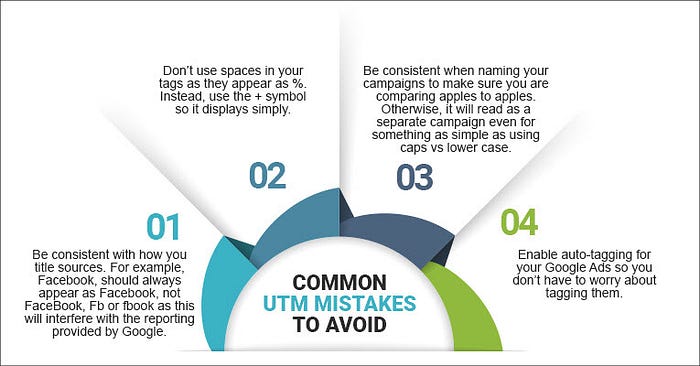Common UTM Mistakes and How to Avoid Them

Common UTM Errors and How to Solve Them
UTM tags are essential tools for digital marketers to measure and optimize the performance of their campaigns. These tags enable you to track the sources of traffic reaching your site and understand how different campaigns are performing. However, many marketers — whether experienced or new — fall into common UTM mistakes. These errors can negatively impact campaign data accuracy, potentially leading to poor decision-making or missed opportunities. In this article, we’ll explore some common UTM mistakes and how to solve them, along with tips on how using the right UTM builder tool can help streamline the process.
1. Inconsistent UTM Tagging
One of the most common UTM mistakes is inconsistent tagging. Marketers may fail to standardize their UTM parameters, which results in fragmented data. Inconsistent use of capitalization, spacing, hyphens, and underscores can cause confusion when analyzing campaign results. For example, using “utm_medium=socialmedia” in one instance and “utm_medium=social-media” in another can create discrepancies in your data.
To solve this issue, ensure consistency in your UTM tags. This means choosing a naming convention (e.g., lowercase letters, hyphens instead of underscores) and sticking to it across all campaigns. A reliable UTM builder can help you generate consistent tags, reducing the chances of human error.

2. Ignoring UTM Tracking for Social Media Campaigns
Social media campaigns are a critical part of any digital marketing strategy, but many marketers neglect to apply UTM tags to their social media posts and ads. This omission can lead to a lack of insight into which social channels are driving traffic and conversions.
By adding UTM parameters to your social media campaigns, you can clearly track which platforms (Facebook, Twitter, Instagram) are bringing the most traffic. This helps you refine your strategy and optimize engagement. You can use a UTM URL builder to quickly add tracking tags to your social media links, ensuring that you’re capturing detailed performance data.
3. Forgetting to Track Performance Continuously
Setting up UTM tags is only the first step. Marketers often forget to continuously monitor and analyze campaign performance after the tags are implemented. Without regular tracking, you may miss opportunities to optimize your campaigns and improve ROI.
To solve this, ensure you regularly check metrics like clicks, conversion rates, and bounce rates. Active monitoring of UTM data will help you adjust your strategy based on real-time performance. Using a UTM builder tool to manage your tags can simplify the process and ensure accurate tracking across all your campaigns.

4. Formulating Excessively Complicated UTM URLs
While it’s important to track key information with UTM tags, creating overly long or complicated UTM URLs can make analysis cumbersome and error-prone. Complex URLs are harder to share and may lead to mistakes in the tracking process.
To avoid this, keep your UTM URLs concise and focused on essential parameters such as the source, medium, and campaign. A UTM builder can help you generate clean and simple URLs that are easy to manage and share, while still providing the necessary tracking information.
5. Using the Wrong Tool to Create UTM Tags
There are many tools available for generating UTM links, but using the wrong one can lead to incomplete or inaccurate tagging. Some tools may not support certain UTM parameters or may create tracking errors.
It’s essential to use a reliable UTM builder tool to generate your UTM links. Tools like the Google Campaign URL Builder or a specialized URL builder like Google UTM Builder, UTM.io, TeamCamp’s UTM URL Builder allow you to create accurate UTM links with the required parameters. This will help ensure that your tracking is consistent and your data is reliable.

6. Overlooking to Tag Campaigns Across All Marketing Channels
Another common mistake is forgetting to tag campaigns across all marketing channels. Marketers may focus on paid search, email, or organic traffic, while neglecting referral links, affiliate programs, or offline campaigns like QR codes.
To ensure complete campaign tracking, make sure you apply UTM tags to every marketing effort, whether it’s digital or offline. This includes social media posts, display ads, and even flyers with QR codes. By using a UTM builder to tag every link, you can gain a clear understanding of where your traffic is coming from and which campaigns are most effective.
7. Misinterpreting UTM Data Attribution
Misunderstanding how UTM data is attributed is another pitfall many marketers face. While UTM tags track traffic, they may not give you a full picture of the customer journey. For example, a customer may click on a UTM-tagged link in an email and later return via organic search. Both channels could receive credit for the same conversion, leading to inaccurate attribution.
To address this, consider using multi-channel attribution models, which give you a clearer picture of how different marketing channels contribute to conversions. Tools like Google Analytics’ Multi-Channel Funnels can help you analyze the full customer journey and allocate credit to all touchpoints. A well-integrated UTM builder can make it easier to track and attribute data across multiple channels.

FAQ
1. What do UTM tags track?
UTM tags are used to track the performance of online marketing campaigns. They append parameters like source, medium, and campaign to a URL, allowing marketers to analyze traffic and conversions more accurately.
2. What are the most common UTM mistakes for marketers?
The most common UTM mistakes include inconsistent tagging, ignoring social media tracking, forgetting continuous performance monitoring, creating complicated UTM URLs, using the wrong tool for tag creation, and not tagging all marketing channels.
3. How can I ensure consistency in UTM tagging?
Establish a standardized naming convention for your UTM parameters, including consistent capitalization, punctuation, and formatting. Using a UTM builder tool can help you maintain uniformity across all your campaigns.
4. Can UTM tags be used for social media?
Yes! Applying UTM tags to social media posts allows you to track traffic and engagement from different platforms. Using a URL builder makes it easy to add UTM tags to your social media links.
Conclusion
UTM tags are a powerful tool for tracking and analyzing campaign performance, but mistakes can lead to inaccurate data and missed opportunities. By avoiding common errors and using a reliable UTM builder tool, you can streamline your tagging process, ensure data consistency, and make more informed decisions to optimize your marketing efforts.

Comments
Post a Comment